Rimfire rifles are a lot of fun to shoot, with minimal expense, recoil, and noise. As one of our testers said, we believe in recycling plastic water bottles, but only after they has been properly perforated. Banging away at filled water bottles with 22 rimfires offers some exciting impacts and a lot of fun for novice and experienced shooters. We’ve had quite a few email requests to test 22 rimfire rifles, and we were specifically asked to test a Henry Classic Lever 22 and Browning BL-22 head-to-head. We also threw in the mix a Taylor’s Scout. With this match-up of 22 rimfire lever actions, we held our own against those pesky polymer water containers and discovered the reason we have so little 22 rimfire ammo on hand. The ammo shortage is not because we can’t find ammo to buy, it’s because we use up so much ammo in testing.
Besides plinking and fun, we feel that any of these rifles would also make great small-game hunting rifles or pest-control choices. Common features of these rifles include straight-grip wood stocks, exposed hammers, 14- to 15-round-capacity tube magazines, adjustable open sights, the ability to mount an optic, plastic buttplates, and no manual safeties. The rifling twist rate in the three rifles was 1:16 inches, which is the typical 22 rimfire rifling rate. The Henry and Browning offer a bit more versatility because they are compatible with Short, Long, and Long Rifle 22 rimfire cartridges.
How We Tested
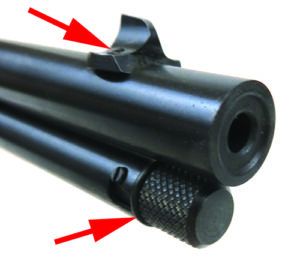
Besides shooting the aforementioned plastic bottles, we performed our accuracy testing on ultra-bright fluorescent-yellow-and-red bullseyes on Thompson Target paper targets set at 25 yards. The black open sights on the rifles are easier to see on these targets. Ammo used included Remington Thunderbolt with a 40-grain lead round-nose bullet (LRN), a CCI Blazer 38-grain LRN, plus Winchester Xpert high-velocity rounds loaded with a 36-grain HP bullet. The latter is a hunting round. Using our range bag as a rest, we were able to shoot some nice groups with these rifles. In some cases, the group were one ragged hole. For our speed-shooting test, we placed White Flyer clay trap/skeet targets in various spots on a dirt berm at 35+ yards. The intent was to fire offhand and see how fast we could fire follow-up shots to pulverize the clay pigeons. As far as speed is concerned, the Browning stole the show with its short-stroke lever. We did notice the Henry took a bit longer to cycle, but its silky-smooth lever was still fast. We also noticed that we short-stroked the Taylor’s in the beginning after shooting the Browning and initially thought it was dud ammo. More on that later.
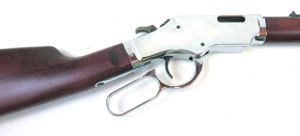
Loading the tubular magazines on these rifles takes more time when compared to a box-magazine-fed rifle, but the tube magazines offer four to five extra rounds. When we load these rifles, we do not fully remove the inner brass magazine tube. We just extend it to open the loading port. This way it does not get handled, so it does not corrode or get dirty.
After all the plinking and target work, in our opinion, the Taylor’s Scout, Henry Classic Lever 22, and Browning BL-22 Grade I all check the boxes for a fun-to-shoot rimfire. Still, we started to favor one over the others during our range sessions.
Gun Tests Grade: A-
$594
The Taylor’s & Co. Scout looks a shrunken version of the iconic Winchester Model 1873. The bright-silver receiver is highly polished. In fact, these are aluminum plates that screw onto the actual receiver. There is just right combination of bling and Old West look. The combination of silver receiver, barrel band, and lever, with blued barrel, trigger and hammer, plus satin walnut wood, makes for an eye-pleasing rifle. Wood-to-metal fit was good as well.
| Action Type | Lever-action, exposed hammer |
| Overall Length | 37.0 in. |
| Barrel/Twist Rate | 19 in.; 1:16 RH Twist |
| Overall Height | 7.37 in. |
| Weight Unloaded | 5.9 lbs. |
| Weight Loaded | 6.5 lbs. |
| Sight Radius | 15.12 in. |
| Receiver | Alloy steel |
| Action Finish | Bright silver |
| Barrel Finish | Blued steel |
| Magazine Capacity | 14 LR |
| Magazine Type | Tube |
| Stock | Smooth walnut |
| Drop at Comb | 1.87 in. |
| Drop at Heel | 2.5 in. |
| Bedding | None |
| Buttplate | Solid plastic |
| Length of Pull | 14.12 in. |
| Front Sight | Blade |
| Rear Sight | Adjustable semi-buckhorn blade; receiver drilled and tapped |
| Trigger Type/Pull Weight | Single-stage, 2.5 lbs. |
| Manual Safety | None |
| Warranty | 1 year |
| Telephone | (540) 722-2017 |
| Website | TaylorsFirearms.com |
| Made In | Italy (Uberti) |
Topside of the receiver, there are three drilled-and-tapped holes to attach a scope mount. We like this option and set up. The iron sights consist of a post front and notch rear, both set in a dovetail with a set screw. You can adjust for windage, but not elevation. And like the Model ’73, when the hammer is fully forward, it blocks the rear sight from view. This was the 19th Century equivalent of the dummy light on a dashboard. If you can’t see the rear sight, cycle the lever. This design feature also forces the user to change his head position to see if he hit a target. With the Henry and Browning, you can view the sights and target even with the hammer fully forward.
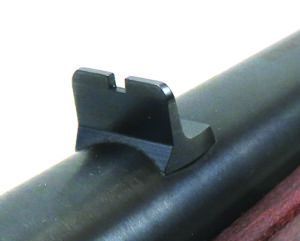
The stock design of the Scout follows the Model ’73. All rifles differed on their drop at comb and heel and length of pull measurements. Testers felt some rifles were more comfortable to operate than others. All were easy to operate. This fit difference is not a deal killer for any of the three rifles, but it is something to keep in mind if you are looking for the most comfortable rifle to shoot.
In hand, the Scout is thin and trim — but heavy — at nearly 6 pounds. The hammer is large and serrated, with plenty of texture. It has a half-cock safety feature. There is no rebounding hammer-safety mechanism. While the Scout looks like a Model ’73, the mechanism is very different. The Scout uses a controlled-round feed mechanism, not the elevator mechanism of the Model ‘73.
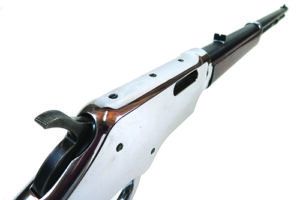
The lever was smooth to operate and large enough for ham-fisted users. We did notice we could short-stroke the rifle and still pull the trigger. The rifle would not fire, and we thought we had a bunch of dud rounds, but we did not see any primer hits on the ammo. We soon determined we were not fully closing the lever. We needed to squeeze the lever to the stock and fire the rifle. It was lazy lever manipulation on our part and helped us suss out the nuances of each lever action. Spring tension pushed the lever out of battery, so if the lever is out of battery and the trigger is pulled, the hammer will fall, but the rifle will not fire. The user needs to squeeze the lever fully closed to fire the rifle.
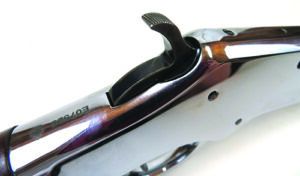
To load, the inner magazine tube is rotated a few degrees and pulled out of the outer magazine tube. The end is knurled for easy twisting. We also liked the loading-port setup in the outer magazine tube. The port is cut to look like the silhouette of a rimfire cartridge so the user knows to insert cartridges base first into the tube. The port is also cut into the side instead on the bottom edge. This helps when loading and a round slips. It is caught between the barrel and tube and doesn’t fall to the deck.
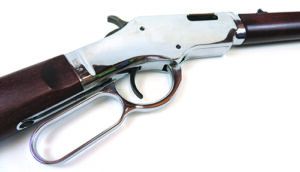
The trigger had no creep and broke at 2.5 pounds. Very nice. This allowed us to shoot some very small groups. In fact, with Remington Thunderbolt ammo, our best group measured 0.35 inches. And that was with open sights. On average with Winchester and CCI Blazer ammo, groups ranged from 0.8 to 1.06 inches. The Scout was the least accurate of the three rifles tested, and the only way we know this is because we measured to two decimal places. The sights were dead on and did not need adjusting. This rifle was fast to cycle from the shoulder, and if we fully closed the lever, we had no function issues.
Our Team Said: We’d buy the Taylor’s if we wanted a rifle design to look like the classic Winchester Model 1873. We like the ability to mount an optic, and we thought accuracy was good and the trigger was superb for a lever-action rimfire.
22 LR Range Data
| CCI Blazer 38-grain LRN | Taylor’s & Co. Scout | Browning BL-22 Grade I | Henry Classic Lever Action 22 |
| Average Velocity | 1231 fps | 1285 fps | 1225 fps |
| Muzzle Energy | 128 ft.-lbs. | 134 ft.-lbs. | 127 ft.-lbs. |
| Smallest Group | 0.80 in. | 0.74 in. | 0.49 in. |
| Average Group | 0.86 in. | 0.77 in. | 0.76 in. |
| Winchester Xpert HV 36-grain HP | Taylor’s & Co. Scout | Browning BL-22 Grade I | Henry Classic Lever Action 22 |
| Average Velocity | 1179 fps | 1216 fps | 1267 fps |
| Muzzle Energy | 111 ft.-lbs. | 127 ft.-lbs. | 128 ft.-lbs. |
| Smallest Group | 0.93 in. | 0.58 in. | 0.59 in. |
| Average Group | 1.06 in. | 0.62 in. | 0.87 in. |
| Remington Thunderbolt 40-grain LRN | Taylor’s & Co. Scout | Browning BL-22 Grade I | Henry Classic Lever Action 22 |
| Average Velocity | 1173 fps | 1216 fps | 1214 fps |
| Muzzle Energy | 122 ft.-lbs. | 131 ft.-lbs. | 131 ft.-lbs. |
| Smallest Group | 0.35 in. | 0.48 in. | 0.64 in. |
| Average Group | 0.48 in. | 0.59 in. | 0.82 in. |
Value Guide: 22 Rifle Rankings
| Gun Name | Issue | Grade | Comments |
|---|---|---|---|
| Savage Model 64 Takedown 40207 22 LR, $212 | Sept. 2020 | A | Best Buy. Basically a Model 64 barrel and action attached to an abbreviated polymer stock. |
| Ruger 10/22 Takedown 11100 22 LR, $372 | Sept. 2020 | A | Our Pick. This has all the performance the iconic 10/22 is known for in a compact package. |
| KelTec Model SU22CA 22 LR, $373 | Sept. 2020 | A- | While not a true takedown rifle, the folding stock on the SU-22CA makes it easy to stow and go. |
| Smith & Wesson M&P 15-22 22 LR, $500 | Mar. 2020 | A | Best Buy. The Smith & Wesson M&P 15-22 operated as we wanted and shot well. It won’t break the bank. |
| Walther Arms HK416 D145RS 578.03.01 22 LR, $583 | Mar. 2020 | B | If you’re looking for an M27 clone, it’s worth thinking about. |
| Anschütz MSR RX22 22 LR, $900 | Mar. 2020 | C | The Anschütz RX22’s trigger wasn’t the best, its buttpad fell off repeatedly, and no one liked its open sights. |
| ISSC MK22 ISSC211000 22 LR, $270 | Mar. 2020 | F | Showed ongoing failures to feed and extract. The blems on the sides of the receiver put us off. |
| German Sport Guns GSG-StG44 GERGSTG44 22 LR, $330 | Feb. 2020 | A | Our Pick. The action had very similar stampings to what you would find on the historical firearm. |
| Walther Arms Colt M4 Carbine 5760300 22 LR, $350 | Feb. 2020 | B | The Walther Arms Colt 22 LR M4 looks almost identical to the standard-issue Colt centerfire rifle. |
| Walther Arms HK MP5 A5 5780310 22 LR, $390 | Feb. 2020 | C | As tested, the stock limited the enjoyment of the firearm and was completely unacceptable for the price. |
| Chiappa Citadel CIR22M1W 22 LR, $300 (Two guns) | Feb. 2020 | F, C | While the Chiappa looks very similar to a classic M1 Carbine, too many of the parts were made of plastic. |
| TPS M6 M6-100 22 LR/410 Bore, $487 | Jan. 2020 | A | Our Pick. The M6 follows in the footsteps of the previous M6 design and does it it better. |
| Rossi Matched Pair 22 LR/410 bore, $182 | Jan. 2020 | A | We liked the sights, the ease of disassembly, and handling of this gun. You get a lot of gun for the price. |
| Savage Model 42 Takedown 22440 22 LR/410 Bore, $425 | Jan. 2020 | B+ | The gun has some fine attributes: accuracy and simple disassembly/reassembly. |
| Hunting Tactical Super Sixty HTSSA1 22 LR, $500 | Nov. 2019 | A | From the extended bolt release to the super-sharp 3.8-pound trigger, the Super Sixty is an exceptional rifle. |
| Adaptive Tactical Ruger 10-22 Build 22 LR, $635 | Nov. 2019 | A | We would have liked a better trigger, but we didn’t feel limited by it, as the accuracy results show. |
| Thompson Center T/CR22 12299 22 LR, $350 | Nov. 2019 | A- | Reliable, accurate, and light. If we were grading for best truck gun, one of the raters said this is it. |
| Mossberg 715T 37209 22 LR, $254 | Nov. 2019 | B- | Reliable, but the least accurate rifle, and the plastic shell didn’t look very good against the nicer rifles. |
| Savage MKII FV-SR Threaded Barrel 28702 22 LR, $248 | Jul. 2018 | A- | Affordable and a great shooter. Shot lights out with the Eley subsonic load. |
| Ruger American Rimfire Standard 8305 22 LR, $309 | Jul. 2018 | B+ | This is a well-thought-out rifle with a lot of flexibility. We liked its cheekweld best. |
| CZ-USA 455 American 02114 22 LR, $373 | Jul. 2018 | B+ | Clean lines and the best shooter with the suppressor on. Would have liked a slightly higher comb or less pitch. |
| CZ-USA CZ 455 American 02110 22 LR, $400 | Jun. 2017 | A | Best Buy. The CZ 455 is our pick as the best all-round, go-anywhere, do-anything bolt-action rifle. |



























